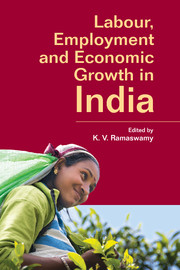Book contents
- Frontmatter
- Dedication
- Contents
- List of Tables and Figures
- Preface
- Part 1 Economic Growth and Employment
- 1 Introduction and Review of Issues
- 2 India's Labour Market during the 2000s
- 3 Services-led Growth and Employment in India
- 4 Growth, Structural Change and Poverty Reduction
- 5 Age Structure Transition, Population Ageing and Economic Growth
- 6 Labour Intensity in Indian Manufacturing
- 7 Gender Discrimination in Manufacturing Employment in India, 1999-2009
- Part 2 Employment and Labour Law
- Contributors
- Index
2 - India's Labour Market during the 2000s
from Part 1 - Economic Growth and Employment
Published online by Cambridge University Press: 05 June 2015
- Frontmatter
- Dedication
- Contents
- List of Tables and Figures
- Preface
- Part 1 Economic Growth and Employment
- 1 Introduction and Review of Issues
- 2 India's Labour Market during the 2000s
- 3 Services-led Growth and Employment in India
- 4 Growth, Structural Change and Poverty Reduction
- 5 Age Structure Transition, Population Ageing and Economic Growth
- 6 Labour Intensity in Indian Manufacturing
- 7 Gender Discrimination in Manufacturing Employment in India, 1999-2009
- Part 2 Employment and Labour Law
- Contributors
- Index
Summary
Introduction
This chapter examines the major trends in India's labour market, mainly during the 2000s. A chapter of this nature is relevant for a number of reasons. First, India's GDP growth has experienced a marked acceleration, especially after the mid-2000s. India today has the distinction of being second only to China in terms of economic growth, among the large economies of the world. Second, market-oriented economic reforms, which began in India in 1991, have taken much deeper roots in the country by the 2000s. At the same time, there has also been an increasing recognition among India's policymakers and the political class that economic growth needs to be ‘inclusive.’ It is important to understand how India's labour market has behaved during such a period of far-reaching economic and policy changes. Third, this chapter is also relevant in the context of the general perception, particularly in the media, that India possesses the so-called demographic dividend. That is, India's large and relatively young population would prove to be a major advantage for the country's future economic growth. According to estimates by the World Bank, India's population in the age group of 15 to 59 years is expected to increase from 757 million in 2010 to 972 million in 2030, whereas population in the working age years is expected to decline in most developed regions of the world. Even in China, population in the age group of 15–59 years is projected to decline from 913 million to 847 million between 2010 and 2030. This implies that India could potentially contribute more than 200 million new workers over the next two decades, possibly accounting for a substantial chunk of the net increase in the global labour supply during this period.
The analysis in this chapter is based mainly on the NSSO reports on employment and unemployment in India. All estimates in this chapter, unless otherwise specified, are based on the usual principal and usual subsidiary status (UPSS) of workers.
- Type
- Chapter
- Information
- Labour, Employment and Economic Growth in India , pp. 21 - 56Publisher: Cambridge University PressPrint publication year: 2015
- 6
- Cited by



